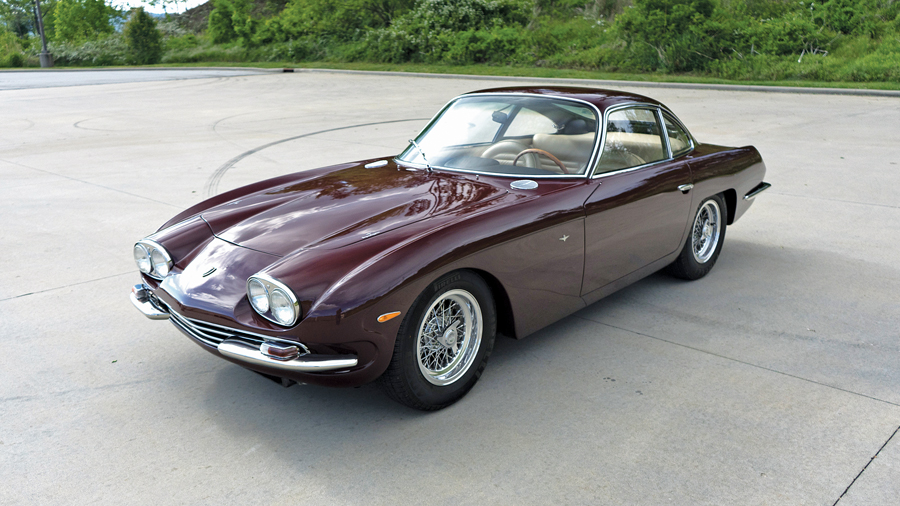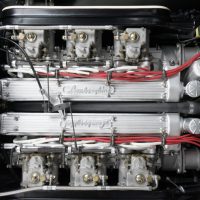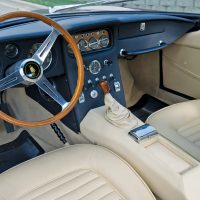SCM Analysis
Detailing
| Vehicle: | 1968 Lamborghini 400GT 2+2 |
| Number Produced: | 247 |
| Original List Price: | $14,750 |
| SCM Valuation: | Median price to date, $561,260; high sale, $869,000 |
| Tune Up Cost: | $595 |
| Chassis Number Location: | Plate on firewall air intake; stamped on right front frame member |
| Engine Number Location: | Inside vee on top of engine |
| Club Info: | Lamborghini Club America |
| Website: | http://www.lamborghiniclubamerica.com |
| Alternatives: | 1968 Ferrari 365 GTC, 1968 Aston Martin DB6, 1968 Maserati Ghibli |
| Investment Grade: | B |
This car, Lot 133, sold for $577,500, including buyer’s premium, at The Finest sale at Hershey, PA, on June 11, 2016.
I will state that I am a big fan of early Lamborghinis, especially the 350GT, 400GT, 400GT 2+2 and Islero models. I owned an Islero for several years and was thrilled by its looks, the engine, handling and comfort. I was also more than satisfied with the appreciation the Islero enjoyed between the time I bought and sold it. All of us in the old-car business have our list of favorites that we passionately feel have been chronically undervalued, which for those who are dealers or brokers mostly means should be more expensive.
“Undervalued” has another meaning, however — one more literal. For an enthusiast, it has to do with the regard in which a car is held and its position in the pecking order in its category. The category in which Lamborghinis are placed is the same as Ferrari, of course, and for many, the Miura is the first Lamborghini worthy of a favorable comparison with a product bearing the Prancing Horse. While the Miura was doubtless groundbreaking on so many fronts, it’s no reason to dismiss its predecessors.
To drive one is to love one
In the firm belief that nothing beats firsthand experience, I will go out on a limb and state that it’s not unlikely that those who don’t think much of the 350 and 400 Lamborghinis as compared to the 275, 330 and 365 Ferraris haven’t spent much time behind the wheel of the Lamborghini. The driving experience is rather different, as the target customers varied as well. Ferruccio Lamborghini built cars for men — and women — who shared his desire for a fast, beautiful car that was also more comfortable and easier to more fully exploit than the comparable Ferrari. The relative quiet of a Lamborghini’s exhaust could be confused for a lack of aural excitement — but it is welcome on a six-hour cross-country drive.
When it comes to power delivery, the 3.5- and 4-liter quad-cam V12 in the Lamborghini is also far smoother, more linear and less peaky than that of the Ferrari, with the notable exception of the 365.
The amount of torque available in top gear at 80 or 90 mph in a 400GT 2+2 makes changing down to pass unnecessary in just about all situations, and you are seldom aware of coming into or passing out of the peak power range. There’s little doubt in my mind that Ferrari developed the 365 in response to Lamborghini.
Lots of information
The online catalog presentation of The Finest is fascinating. As they anticipate that the largest portion of the potential bidding audience may be online and not in fact be present to inspect the car, they provide a level of detail for photography on their website that borders on microsurgery. It is, however, quite useful to see some photos showing defects that you’re unlikely to encounter in a more traditional auction catalog.
The images ran from terribly-evocative-but-rather-too-artsy half-lit studio photos, to the usual location beauty shots of deeply gleaming paint and smooth leather, to detail close-ups of peeling chrome on control levers.
Altogether, The Finest gave what seemed to be a very accurate portrayal of a very attractive — but not perfect — car, one said to be sorted for driving and far more than presentable for casual showing.
The catalog also included an interesting paragraph giving a market analysis of the model, quoting auction comparables and even SCM condition ratings. One thing the description also did was to use nomenclature in a rather casual manner. The first Lamborghini was the 350GT, a three-seat GT. The mid-mounted third seat was soon dropped, and almost all were two-seaters. The larger 4-liter engine was then offered in both the original two-seat version as the 400GT as well as a new 2+2 with a modified floor and longer greenhouse — the 400GT 2+2.
Right on the money
Very few 4-liter two-seaters were built. The number is generally acknowledged to have been 23. They are also known as 400GT Interim cars. Documented examples sell at a large premium over either 350GTs or 400GT 2+2s. “Documented” is important, as the 4-liter was installed at the factory — and at dealers — on 350GTs that required warranty work as well. The indiscriminate use of “400GT” when referring to our subject car might make someone think that the estimate — at $575k to $650k — was very light.
In reality, the estimate seems to have been right on the mark for a very nice, but not perfect, example. Funny that the catalog itself suggests that buying the car for the low estimate would be “a steal.” Well that’s where it sold, but I would instead call it appropriate. Today’s buyer, with money ready to spend, most often finds what he or she needs at exactly the price they want to pay. ♦
(Introductory description courtesy of The Finest.)





